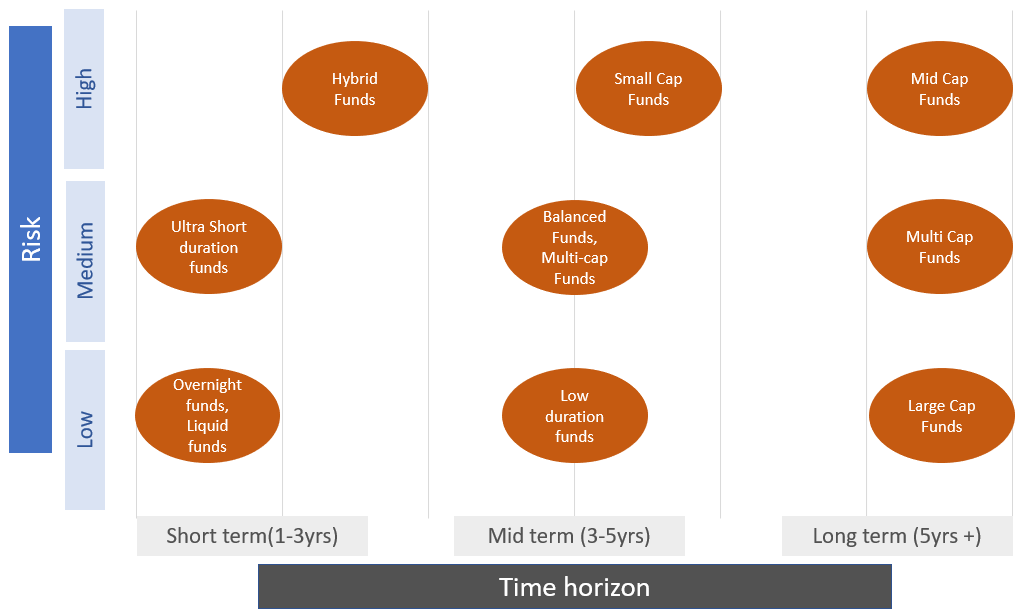Mutual funds are one of the easiest and best ways to invest. That is why investing in mutual funds is an important aspect of one’s investment journey. Careful selection of mutual funds is therefore vital, because incorrect investment choices not only impact financial gains but also lead to undiversified risks. It is important to know that every fund is established with an investment objective. And therefore you must diversify your mutual fund investment portfolio.
Understanding the fund’s investment objective will help you make the right choice. Though it is difficult to comprehend investment objectives each time before investing, there is still some merit to generally knowing the theme of the fund you are planning to invest in.
Mutual funds are subject to market risks
This is a line often heard about mutual funds. To curtail this risk, a fund is managed by a fund manager and the person is a human being – yes really! Their educational background, experience, and presence among people with knowledge of the financial market put them at an advantage. But that does not provide any guarantee of performance or immunity from any downside. That’s why you see a varying degree of returns across fund categories and fund houses, even among funds with a very similar investment objective. Your knowledge can also be good enough (occasionally or over a period) to deal with your investments, but, the in-depth knowledge and understanding possessed by a fund manager combined with the collective wisdom of a fund house often score high. That is why people rely on mutual fund managers and allow them to manage their hard-earned money.
Diversify portfolio to optimize risks and maximize returns
You must diversify your investments even within your mutual funds. Diversification ensures that the portfolio is aligned to your risk appetite and long-term financial objectives. One common mistake is to invest in similar schemes from multiple fund houses. That is just like holding the same security but through different brokerage houses. Have a look at the two successful schemes below and you will understand better.


Source: Data dated November Nov 11th, 2020 from Axis Mutual Fund (www.axismf.com) and ICICI Prudential (www.icicipruamc.com)
Key takeaways:
- Subscribing to both these schemes will create significant investment overlap – both in terms of the underlying securities as well as sectors;
- There is still some difference between schemes, and these can still be considered if you are looking for diversification within the large-cap company space;
- Management fees could still be different for funds otherwise looking similar and can have a bearing on the fund’s performance.
How to select a mutual fund to invest in?
Each person is a unique investor and the selection of mutual funds must be differentiated. One size does not fit all when it comes to mutual funds.
Depending on your risk appetite and time horizon, the chart below demonstrates the type of fund you can opt for. This is only a guideline with a few examples, but this chart could be complex given the number of options available these days.


Habitually analyze your portfolio performance and rebalance
Checking the portfolio performance regularly can be tricky for those with limited knowledge (or interest) in this subject. It is critical to adjust your portfolio and reflect on recent portfolio performance to ensure that the desired level of asset allocation is maintained. Rebalancing also helps you accommodate for any future performance – e.g., if you are optimistic about a sector, you probably want to invest a higher proportion into that sector. Portfolio rebalancing:
- Protects from overexposure to any risks
- Addresses dramatic movement in any specific security or a bond value
Read more on a similar subject in my article on ‘Thumb rules of financial planning’. Keeping track constantly can be cumbersome, but it is recommended that a portfolio review is conducted at least once a year.
Cost of making changes in your portfolio
Any change in portfolio, in general, or due to rebalancing, may involve some costs. These include:
- Exit load in case of mutual funds or transactions tax in case of direct investments in securities and bonds
- Capital gains tax is applicable on the sale of equity investments – depending on the tenure of holding the instrument. In the case of long-term capital gains, the benefit of indexation is available.
How to invest in mutual funds
Investment in mutual funds is very simple and can be either online or offline.
- Online investment – from your bank account, through mutual fund website, or third-party websites (www.moneycontrol.com)
- Offline investment – hire an agent to help complete documentation and purchase formalities or visit the nearest branch of a specific asset management company
Many websites (e.g. www.moneycontrol.com) can provide details of top-performing funds, top-ranked funds to help you decide the best mutual fund to invest into. Analysis of fund’s recent as well as historical performance, comparison vs peers, and the benchmark is also available and will help you finalize.
To conclude
Mutual funds are the preferred choice amongst investors because of the returns they offer and the possibility to diversify. As an investor, you must remember that a single scheme is not suitable for everyone. Every mutual fund scheme should be suitably decided based on (1) investment objective, (2) risk appetite, and (3) time horizon among other parameters.
The procedure to select the right mutual funds requires careful study and may require an expert opinion. Here is one final word of advice – Never rush with investing. There are dozens of mutual fund companies offering hundreds of fund schemes in India. Hence, devoting your time to find out the best one is vital to progress in the right direction and reach your financial goals.
——————————————————————————————————–
The author of this article is a senior finance professional with over fifteen years of work experience in corporate finance and has an affinity towards the subject of personal finance and investment management. Please leave your comment or share thoughts on this article via email at decodefinance.in@gmail.com. For more articles, please visit the website www.decodefinance.in.
Disclaimer:
The article is based on the author’s knowledge, experience, and understanding of the subject. Any views, thoughts, and opinions expressed in the text belong solely to the author, and not necessarily to the author’s employer (past or current), organization, committee, or other group or individual.
Under no circumstances the author shall be liable for any views or analysis expressed in this note. Further, the views expressed are not binding on any authority or Court. Readers are advised to consult their financial advisor for advice for their specific case.





This was really helpful in understanding.
useful article to understand basics of investment
Good information
Very well. Written and good. Insights
A well written article. Even the uninitiated can understand the topic clearly.
SIPs are better many times as loss gets average out and you are still in profits.